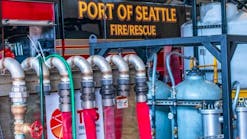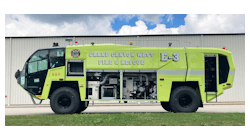New Aircraft Rescue and Firefighting (ARFF) equipment offers airports a variety of new features and equipment from several manufacturers that have evolved in recent years. Picking the right equipment to meet your airport’s needs is a challenging task for any manager who wants to provide the best solution to meet the call of an emergency situation on the airfield.
MidAmerica St. Louis Airport (BLV) was awarded a federal grant in June 2022 to replace a 25-year-old ARFF unit, bringing significant technology upgrades along the way.
BLV Director Bryan Johnson shared these insights how the airport decided when and how to upgrade its equipment.
When is it Time to Buy a New ARFF Unit?
The FAA defines the minimum useful life of an ARFF truck as 15 years (FAA Order 5100.38D). Johnson said BLV’s 1,500 gallon truck was purchased in 1997. The maintenance costs of this vehicle have gradually increased over the last several years as have the challenges associated with this maintenance.
While the FAA will fund a major rehabilitation of an ARFF vehicle over 10 years in age if the major rehabilitation were to extend the useful life of the vehicle by 10 or more years, Johnson said internal airport analysis indicated that a new vehicle would be more cost effective over the long run and many of the features on the new models would be beneficial to our operations.
Plan for the Funding Challenges
Johnson said BLV experiences the same challenges as every other airport--greater funding needs than funding availability.
The airport originally programmed truck replacement at an earlier date but decided it could continue to maintain the truck for a longer period of time while BLV utilized the available AIP funding for other needs. Once some of those imminent needs were met, leaders fit the ARFF truck back into the ACIP.
Johnson said it’s important to bear in mind that the process from solicitation to award to grant to vehicle delivery is a long process. Programming two years for the total process is realistic.
Determine What You Need
BLV utilized FAA Airport Improvement Program funds for this project. As such, the solicitation was an open and competitive bid process. Johnson said they utilized FAA AC 150/5220‐10E to prepare the specifications based on the airport’s existing ARFF index and selected the lowest responsive and responsible bid.
The contract was awarded to Oshkosh for the Striker 4x4. BLV leaders were happy with the outcome as the existing airport ARFF fleet is composed of Oshkosh trucks, Johnson said, and the mechanics are familiar with the equipment.
He said the most important thing was to purchase the correct class of vehicle for the ARFF Index.
What Stakeholders Should You Get Involved?
Crucial stakeholders for BLV were the ARFF truck users and the mechanics who will maintain them. The airport’s chief mechanic is also a volunteer firefighter and very knowledgeable on ARFF trucks.
Prepare for Delivery
BLV added an extra bay to its ARFF facility. The new truck will fit in the new bay or either of the existing two bays. All ARFF and maintenance staff and the mechanics will be trained on the new vehicle as delivery approaches.
The delivery date for the vehicle is 365 calendar days from the order, so Johnson said they have ample time to prepare.
BLV will continue to maintain the existing ARFF truck until the new truck is fully operational. Once the new truck is fully operational, Johnson said they intend to sell the existing truck.
Johnson said the airport doesn’t expect any impacts to the Part 139 inspection process because the old truck maintained fully operational capacity. However, a new truck reduce ARFF truck maintenance needs thereby freeing up time and resources for maintenance staff.




